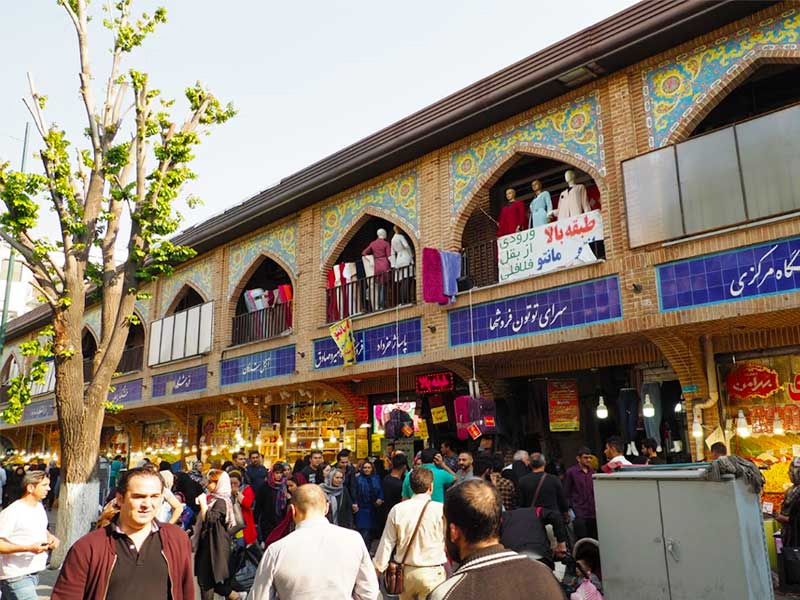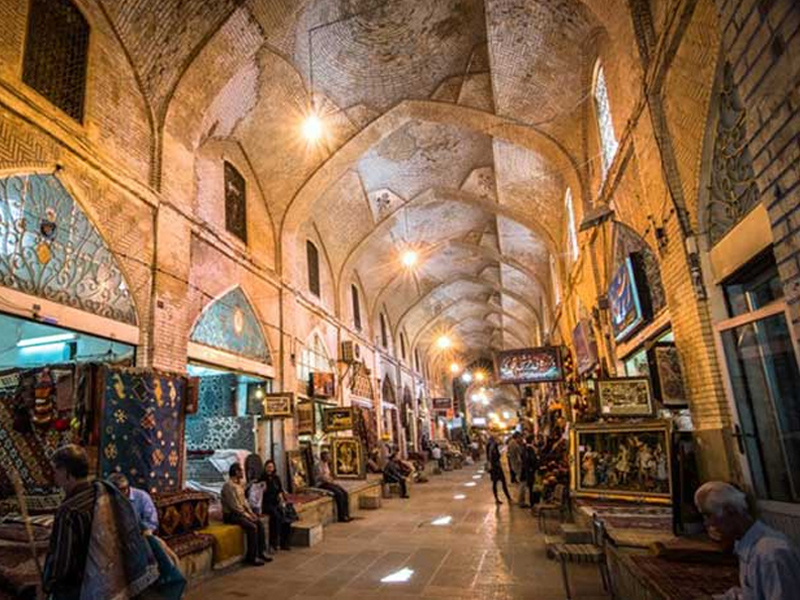Tehran Bazaar is one of the most important historical sites in the capital city. It is located in the old fabric of the city, on 15 Khordad Street, which is still considered the beating heart of Tehran’s economy. Tehran Bazaar is of great interest to domestic and foreign tourists in terms of economy, history, and culture. Visitors can spend hours wandering through its caravanserais, Timchehs, and various markets, enjoying the beauty of this grand bazaar. In this article from Eligasht, we will provide a complete introduction to Tehran Bazaar and its different sections.
Book Iran Air flights from London to Tehran and Tehran to London with Eligasht UK:
Tehran Bazaar’s Location
Before we delve into the introduction of Tehran Bazaar, let’s see where it is located. This bazaar is situated in the old fabric of the city and the authentic neighborhoods. Tehran Bazaar is bordered by Pamenār Street to the north, Molavi Street to the south, Sangelaj Street to the west, and 15 Khordad Street to the east.
Address of Tehran Bazaar: Tehran – Southern side of 15 Khordad Street, between Molavi, Khayyam, and 17 Shahrivar Streets.
Access to Tehran Bazaar
The method of accessing the grand bazaar of Tehran depends on your means of transportation. The best means to reach this bazaar is by metro, as Tehran Bazaar is located within a traffic-restricted zone and even experiences heavy traffic on holidays.
Metro to Tehran Bazaar:
If you approach Tehran Bazaar from 15 Khordad Street and Khayyam Street, the 15 Khordad Station is the best choice for accessing the bazaar. After exiting this station, you should head towards Sabzeh Meydan. However, if you are on Molavi Street or Mustafa Khomeini Street, the best metro station to disembark is Meydan-e Mohammadieh.
Access to Tehran Bazaar by Private Car:
To access Tehran Bazaar by private car, you need to have a traffic restriction permit. Then, you can enter Khayyam, Molavi, 15 Khordad, or Mustafa Khomeini Streets and drive yourself to the bazaar. Due to heavy congestion on these routes and the lack of parking, you will need to park your car in the surrounding alleys.
Access to Tehran Bazaar by Taxi:
If you want to go to this Bazaar by taxi, your destination will be Galubandak. You can take a taxi from different parts of the city, such as Fatemi Square, Azadi Square, or Enghelab Square, and once you reach Galubandak, you can proceed to the vicinity of the bazaar.
Access to Tehran Bazaar by Bus:
If you are on 15 Khordad Street or Khayyam Street, you should disembark from the bus at Galubandak station. If you are on Molavi Street, you need to disembark at Meydan-e Mohammadieh. If you have traveled from Mustafa Khomeini Street towards the bazaar, you should disembark at the Molavi intersection and make your way to the bazaar.

Working Hours of Tehran Bazaar
The working hours of Tehran Bazaar are from 8:30 AM to 5:00 PM on Saturdays through Thursdays. However, the shops in the external section of the bazaar operate until 8:00 PM from Saturdays through Thursdays and until 5:00 PM on Fridays. Additionally, the bazaar is closed on Fridays and official holidays.
History
There are differing opinions about the history of Tehran Bazaar and the exact time of its construction. Some believe that the current bazaar in Tehran is a remnant from the Qajar era, especially during the reign of Nasser al-Din Shah, while others believe that this structure dates back to the Safavid period and the time of Shah Tahmasb Safavi. An English nobleman and traveler named Thomas Herbert, who visited this bazaar in 1108 (during the Safavid period), described the Tehran Bazaar as a market without a roof in his writings.
During the Safavid era and the reign of Shah Tahmasb, Tehran was a small and picturesque city near the famous city of Ray. Shah Tahmasb used to visit Ray frequently to pay homage to Imam Abdul-Azim. During these visits, he became interested in Tehran and ordered the construction of a wall around the city with four gates. The soil for building this wall, later known as the Tahmasbi Wall, was collected from two areas in Tehran known today as Chaleh Meydan and Chaleh Hesar.
There was also a government fortress near the Tahmasbi Wall, which had a moat separating the city from the fortress. Over time, vendors, stalls, and chambers began to sell goods around this moat, and this place became known as “Khandagh Market” (the Moat Market). The Khandagh Market continued its activities with the same name during the Safavid and Zand periods and gained the attention of the kings. Many researchers consider the nucleus of the Tehran Bazaar to be related to the Safavid period due to its proximity to the Tahmasbi Wall.
During the Qajar period, this Bazaar expanded, and many sections were added to it. Agha Mohammad Khan, after choosing Tehran as the capital, reconstructed various parts of the bazaar such as alleys, chambers, and caravanserais. After him, during the reign of Fath Ali Shah, the Jameh Mosque of the Bazaar, Chaharsogh-e Bozorg and Koochak markets, and the Marvi Bazaar and Chehel-Tan Bazaar were built.
During the reign of Nasser al-Din Shah Qajar, the Between-the-Two-Holy-Shrines Bazaar was established, and the main entrance to the bazaar, known as the Grand Bazaar, was added to this complex. Nasser al-Din Shah also organized other entrances to the bazaar and ordered the construction of Marvi Bazaar and Sadr-Azam Timcheh. Other parts that were added to the Tehran Bazaar during the Qajar period were the Moeir Bazaar, the Qavam ol-Dowleh Bazaar, the Naib ol-Saltaneh Bazaar, and the Karbalai Abbas Ali Kamargachi Bazaar.
Related post
Discovering the Best Boutique Hotels in Tehran for a Unique and Luxurious Stay
From Lalehzar to Lolagar Alley: Exploring the Charms of Old Tehran
Architecture
The architecture of grand Bazaar is similar to other traditional markets in Iran, with its narrow and winding alleys, vaulted ceilings, and domes. Tehran Bazaar, with an area of approximately 100 hectares, does not have a specific architectural style and has suffered damages in different periods.
This bazaar gradually expanded, and new alleys were added to it, competing with each other. Also, during the Qajar period, the weather led to the roofing of some parts of the bazaar, and spaces such as coffee houses, mosques, public baths, husseiniyehs (religious gathering places), purchases (traditional gyms), and sqaqakhanehs (water reservoirs) was created.
At the intersection of two important streets in the bazaar, there are the Four (Chahar) Soghs. The Four Soghs are octagonal spaces with beautifully plastered short domes, built in 1222. The northern axis of the Chahar Soghs leads to 15 Khordad Street, the southern axis to Molavi Street, the eastern axis to Khayyam Street, and the western axis to Mostafa Khomeini Street.
Currently, the oldest sections of the Tehran Bazaar include the Amir Bazaar, the Grand Chaharsogh, parts related to the Jameh Mosque, and the Sardar-e Sabzeh Meydan. Also, the old sections of the bazaar, such as the domes and vaults with windows that direct light inside and create air circulation, still showcase their beauty in the most magnificent form.

Introduction to Different Sections of Tehran Grand Bazaar
If we want to provide a brief introduction to the different sections of the Tehran Grand Bazaar, we need to mention the following categories:
- Sarais (caravanserais) of Tehran Bazaar: Abu Torab Caravanserai, Eslami Caravanserai, Amir Kabir Caravanserai, Bu Ali Caravanserai, Tehranchi Caravanserai, Javaherian Caravanserai, Dalan Deraz Caravanserai, Delgosha Caravanserai, Sheikh Jafar Caravanserai, Ghadyani Caravanserai, Karbasi Caravanserai, Golshan Shekan Caravanserai, Mesbah Caravanserai, Mahdizadeh Caravanserai, Mirza Esmail Caravanserai, No Qazviniha Caravanserai, Vaziri Caravanserai, and Yazdiha Caravanserai.
- Timchehs (covered passages) of Tehran Bazaar: Haji Abu Torab Timcheh, Bavafa Timcheh, Fard Timcheh, Hajeb ol-Dowleh Timcheh, Tavajjoh Timcheh, Molla Ali Kani Timcheh.
- Pasajes (modern shopping arcades) of Tehran Bazaar: The most important pasajes include Ahmadi Pasaj, Azadi Pasaj, Eslamiyeh Pasaj, Iran Yaraq Pasaj, Jafari Pasaj, Darbandeh Pasaj, Shams Pasaj, Sedghiani Pasaj, Kavoosi Pasaj, Mahtash Pasaj, Vahdat Pasaj, and Mahdi Pasaj.
- Bazaars and bazaar squares of Tehran Bazaar: The notable bazaar squares include Amir Bazaar, Bein Ol-Haramayn Bazaar, Persian Gulf Bazaar, Darvazeh Nou Bazaar, Zargarha Bazaar, Abbasabad Bazaar, Kilooyiha Bazaar, Masjed Jame Bazaar, Mesgarha Bazaar, and Najarha Bazaar.
Historical Attractions Around the Bazaar
The most notable historical attractions around the Tehran Bazaar are:
– Sabzeh Meydan, a square built during the Safavid period.
– Mahdiyeh Timcheh, adorned with exceptional decorations.
– Tehran Grand Mosque, registered as a national monument of Iran.
– Imam Mosque or Sultan Mosque, remaining from the Qajar era.
– Historical house of Malek Haj Hussein, belonging to Agha Malek, a wealthy merchant of Mashhad.
– Hajeb ol-Dowleh Timcheh, was built during the reign of Naser el-Din Shah.
– Imamzadeh Zeyd.
– Tomb of Lotf Ali Khan, located in the vicinity of Imamzadeh Zeyd.
– Amir Caravanserai, built between 68-1267 AH.
– Chahar Sooq Bazaar, constructed in 1222 AH.
– St. Thaddeus and Bartholomew’s Holy Church, was built during the rule of Karim Khan Zand.
– Imamzadeh Seyed Esmail, dating back to the 9th century AH.
– Martyr Chamran Museum House.
– Imamzadeh Seyed vali Shrine.
Summary of Tehran Bazaar Introduction
In this article, we have provided comprehensive information about the Bazaar, including access to it and its history, and introduced the different sections of the bazaar. As mentioned, grand Bazaar is still one of the main economic centers of Tehran city and a tourist attraction. Every year, many people visit this large complex for shopping or sightseeing. Visiting the Tehran Bazaar is an immersive experience that offers more than just shopping. It is an opportunity to soak in the vibrant atmosphere, interact with locals, and witness the daily life of Tehran residents. The bazaar is not limited to commerce; it is a social hub where people gather, exchange stories, and celebrate the rich tapestry of Iranian culture.

FAQ
1- How old is the Tehran Bazaar?
The Tehran Bazaar has a rich history dating back over 200 years. Its origins can be traced to the Qajar era in the 19th century when it was established as a significant commercial hub in Tehran. Over the years, it has expanded and evolved to become one of the largest and most iconic bazaars in the Middle East.
2- What can I find in the Bazaar?
The Bazaar offers a wide array of products and services. Visitors can explore numerous sections dedicated to specific types of goods. For example, the carpet section is renowned for its exquisite Persian carpets, while the gold and jewelry section showcases intricate designs and traditional craftsmanship. Additionally, you can find shops selling clothing, spices, leather goods, antiques, traditional Persian sweets, and much more.
3-Is bargaining common in the Tehran Bazaar?
Yes, bargaining is an integral part of the shopping experience in the Tehran Bazaar. It is expected that customers negotiate the price with the vendors. Bargaining can be an enjoyable and interactive process, allowing you to potentially secure a better deal. However, it is important to approach bargaining with respect and fairness.

